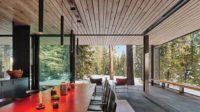Imaginations and children run wild through Olson Kundig’s fanciful rooftop playground in Daegu, South Korea. This surprising project is the third in a series of roofscapes that the Seattle-based firm has conceived for Shinsegae, one of South Korea’s largest retailers. The series began when the client’s representatives, after visiting a children’s museum designed by Olson Kundig (for the Skirball Cultural Center in Los Angeles, Noah’s Ark), wanted to bring a similar concept to their stores. Olson Kundig partner Alan Maskin was immediately intrigued by the opportunity to explore a program that would be a first for the firm, whose diverse repertoire includes a range of building types—from residential to civic to cultural and commercial—as well as product design.
Additional Content:
Jump to credits & specifications
For their latest commission for the retailer, Maskin was essentially given carte blanche to propose a concept for the more than 43,000-square-foot site—the largest so far—atop a department store. The client handed Maskin a single directive: “Design the project around a story or a narrative.”
Drawing inspiration from the Aesop fable “The Town Mouse and the Country Mouse,” the architects designed the park, called Zooraji, to be an immersive fantasy world where young visitors, so they can feel like the mice in the tale, enter a surreal environment at skewed scales, animated by live baobab trees, a collection of towering steel-and-bamboo treehouses, and outsize composite animals made from recycled elements including wine casks, car parts, and even a canoe. (Maskin took a similar approach to designing the handcrafted animals for the Noah’s Ark project.)
The architectural follies—strategically placed atop structural columns—are embedded within a storybook landscape where shrubs, bushes, and climbing plants, growing from gardens and walls, are part of a choreographed effort to transform the mall’s rooftop into an allegorical habitat.
Though the architect’s hand is evident everywhere, from the whimsical animals to the treehouses to the artificial boulders for climbing, Maskin expects evidence of his team’s interventions to fade—in fact, he’s counting on it. “Plants are supposed to grow over time, so the architecture will disappear,” he says. “Landscape has its own timetable.”
CreditsDesign Principal: Alan Maskin
Personnel in architect's firm who should receive special credit Marlene Chen, AIA, LEED AP, Project Manager Laura Bartunek and Jerome Tryon, Project Architect/Design Collaborators
Architect of record: Olson Kundig 159 South Jackson Street, Suite 600 Seattle, WA 98104 206-624-5670 http://www.olsonkundig.com
Associate architect(s): SAMWON Space & Design 112 Saimdang-ro Seocho-gu, Seoul, South Korea (02) 3475 3300 http://samwonsd.co.kr/
Consultants: Dan Hinkley, Plantsman BE-OH, Landscape Design
General contractor: Shinsegae Engineering & Construction
Photographer: Austin Wilson |
SpecificationsMaterial Palette: Treehouses: Custom steel shapes, custom steel and rebar tree branches, bamboo siding, rope
|











